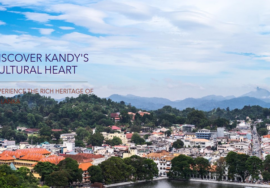
Kandy Esala Perahera: Sri Lanka’s Grand Festival of Faith and Culture
The Kandy Esala Perahera, often simply called the Kandy Perahera, is one of Sri Lanka’s most magnificent and revered cultural festivals. Held annually in the city of Kandy, this grand procession is a vibrant celebration of Sri Lankan heritage, blending religious devotion with stunning displays of traditional art, music, and dance. The Perahera is a testament to the island’s rich history and its deep-seated Buddhist traditions.
The festival, which takes place over ten days in July or August, honors the Sacred Tooth Relic of the Buddha, housed in the Temple of the Sacred Tooth Relic (Sri Dalada Maligawa) in Kandy. The relic is believed to have been brought to Sri Lanka in the 4th century CE and has since been revered as one of the most important Buddhist relics in the world. The Kandy Perahera symbolizes the sanctity of the relic and its importance in Sri Lankan culture.
Each evening of the festival, the city comes alive with the rhythmic beat of drums, the shimmer of silk costumes, and the glow of torchlights. The Perahera is a spectacular procession that features dozens of richly adorned elephants, traditional dancers, drummers, fire-breathers, and colorfully dressed pilgrims. At the heart of the procession is the Maligawa Tusker, a majestic elephant chosen to carry the golden casket containing a replica of the Sacred Tooth Relic, as the actual relic remains securely enshrined in the temple.
The Perahera is organized by four devales (temples) dedicated to Hindu gods who are believed to protect the island: Natha, Vishnu, Kataragama, and Pattini. Each devale has its own procession, which joins the main Perahera, adding to the grandeur of the event. The procession is an intricate blend of Buddhist and Hindu traditions, reflecting the island’s diverse spiritual heritage.
One of the most striking aspects of the Kandy Perahera is the involvement of the whip crackers, who lead the procession by cracking whips in the air, symbolizing the clearing of the path for the sacred relic. They are followed by traditional Kandyan dancers, who perform intricate and energetic routines that have been passed down through generations. The drummers, with their deep, resonant beats, set the pace for the entire procession, while fire dancers and acrobats add to the festival’s sense of spectacle.
The final night of the Perahera, known as the Randoli Perahera, is the most elaborate and grand. It culminates in a water-cutting ceremony (Diya Kepeema) at the Mahaweli River, where priests symbolically cut the water with a sword, signifying the separation of the sacred from the profane.
The Kandy Esala Perahera is more than just a festival; it is a living cultural heritage that connects Sri Lankans to their history, religion, and traditions. It draws thousands of pilgrims and visitors from around the world, offering a unique and unforgettable experience of Sri Lanka’s spiritual and cultural richness.


